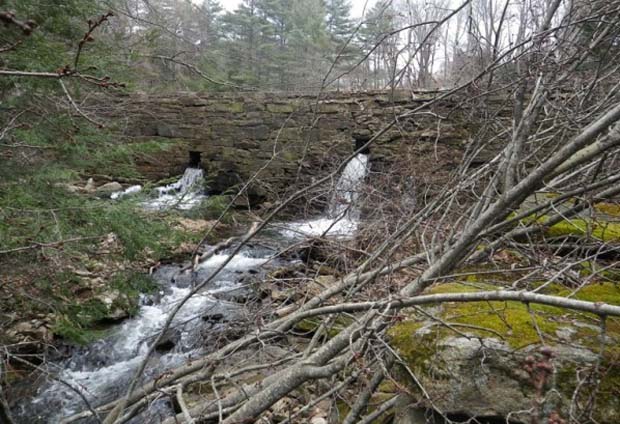A Favorite Massachusetts Stream Loses a Dam – and Gains Aquatic Habitat
Posted by Sandra Postel of National Geographic’s Freshwater Initiative in Water Currents on March 6, 2014
[dropcap]T[/dropcap]he Bartlett Rod Shop Company Dam, built in 1820 on Amethyst Brook in western Massachusetts was removed in November 2012, opening up habitat for trout and creating spawning grounds for sea lamprey.

The Bartlett Rod Shop Company Dam, built in 1820 on Amethyst Brook in western Massachusetts was removed in November 2012, opening up habitat for trout and creating spawning grounds for sea lamprey. Photo by Alex Hackman / MA Dept. of Fish and Game.
In early January, on a visit back to my old stomping grounds in western Massachusetts, I trekked along the snowy banks of Amethyst Brook, a beautiful headwater tributary in the Connecticut River watershed. My mission was to see the site of a dam removed in late 2012.
I’d hiked through this area in the towns of Amherst and Pelham many times before, but had never sought out the stretch of stream blocked by the structure known as the Bartlett Rod Shop Company Dam, after the fly rod manufacturer who began operating alongside the stream in 1864. The dam itself – a 20-foot (6-meter) tall, 170-foot (52-meter) wide rock structure – had blocked the brook since 1820.
Over the decades, the mill had transitioned through many uses, including a woodworking shop, a machine shop, a maker of boiler tube cleaning equipment, and finally to HRD Press, a provider of products and services for human resources development. While the company owned the dam, it didn’t need it.
After receiving a dam safety order from the state in 2007, HRD Press began working with government agencies and conservation groups to study the idea of taking the obsolete dam down. In 2010, Massachusetts officials named the dam’s removal a priority project for river restoration – and by late 2012, thanks to a broad partnership of federal and state agencies, the two towns, and conservation groups, the dam was dismantled.
In the months since, Amethyst Brook has begun to heal.
Freed by the dam’s removal, sediment has moved downstream. So has organic matter in the form of leaves and woody debris, critical to aquatic food webs. Water temperature has dropped, and oxygen levels have increased.
With the dam gone, trout can now move further upstream to high-quality coldwater habitat.
And below the dam site, a stream bottom of gravel and cobbles has formed – habitat just right for the spawning of the migratory sea lamprey.


Join the discussion One Comment